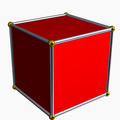Cuboid
In
A special case of a cuboid is a rectangular cuboid, with six rectangles as faces and adjacent faces meeting at right angles. A cube is a special case of a rectangular cuboid, with six square faces meeting at right angles.[1][3]
In attempting to classify cuboids by their symmetries, S. A. Robinson found that there were at least 22 different cases, "of which only about half are familiar in the shapes of everyday objects".[4]
By Euler's formula the numbers of faces F, of vertices V, and of edges E of any convex polyhedron are related by the formula
In the case of a cuboid this gives 6 + 8 – 12 = 2; that is, like a cube, a cuboid has six faces, eight vertices, and twelve edges.
Along with the rectangular cuboids, any parallelepiped is a cuboid of this type, as is a square frustum (the shape formed by truncation of the apex of a square pyramid).
Gallery
-
squarefaces)
-
rectangles)
-
(congruent quadrilaterals)
-
Trapezoidal prism
-
Non-convex cuboid
See also
References
- ^ ISBN 9780521277396.
- MR 1976856.
- ^ Dupuis, Nathan Fellowes (1893). Elements of Synthetic Solid Geometry. Macmillan. p. 53. Retrieved December 1, 2018.
- MR 0746897.
Wikimedia Commons has media related to Hexahedra with cube topology.









